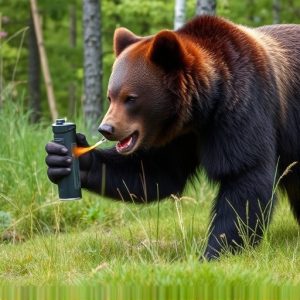Surviving Bear Encounters: Protecting Yourself Beyond Bear Spray
Understanding bear behavior is crucial for preventing attacks. Grizzly and black bears have an excep…….
Understanding bear behavior is crucial for preventing attacks. Grizzly and black bears have an exceptional sense of smell, so hikers and campers must store food securely and avoid attracting them with human food or trash. While loud noises and bear spray are essential safety measures, cold temperatures won't freeze the spray's effectiveness if stored properly. Modern bear spray cans resist freezing, but extreme cold and direct sunlight can degrade performance. Heated storage areas like garages or sheds are ideal. Bear spray is a powerful deterrent, especially in colder climates, but should be used as a last resort within close proximity of aggressive bears. Proper storage, awareness, and preparation significantly enhance safety in bear country by addressing the key concern: can bear spray freeze in storage?
“In wild landscapes, encountering bears is an inevitable reality for outdoor enthusiasts. To ensure safety, understanding bear behavior and equipping yourself with effective protection methods are paramount. This article delves into various aspects of wilderness survival during bear attacks, focusing on bear spray as a primary defense. From deciphering bear behavior to exploring alternative protections, we offer comprehensive guidance. Additionally, storage considerations for cold climates regarding bear spray are addressed, including the potential issue of freezing. Preparedness and response strategies complete our guide, empowering adventurers to navigate these encounters safely.”
- Understanding Bear Behavior: Key to Prevention
- The Efficacy of Bear Spray: A Close Look
- Storage Considerations for Bear Spray in Cold Climates
- Alternative Protection Methods: What You Might Be Missing
- Preparation and Response: Staying Safe During a Encounter
Understanding Bear Behavior: Key to Prevention
Understanding bear behavior is crucial for preventing a potential attack. Bears, especially grizzly bears and black bears, have a strong sense of smell and can detect food from miles away. They are often attracted to human food, trash, or even sweat, which can lead them to campsites and hiking trails. Knowing this, hikers and campers should always store their food securely in bear-resistant containers or hang it at least 10 feet above the ground and 7 feet away from their sleeping areas.
When bears become accustomed to human presence and food sources, they may lose their natural fear of humans, leading to more aggressive behavior. This is why it’s essential to make loud noises while hiking in bear country, carry bear spray, and know how to use it effectively. However, it’s important to note that bear spray can freeze in cold temperatures, so storage should be carefully considered, especially during colder months.
The Efficacy of Bear Spray: A Close Look
Bear spray has long been considered a crucial tool for wilderness survival, especially when navigating bear-infested areas. Its efficacy as a defense mechanism against aggressive bears has made it a popular choice among hikers, campers, and outdoor enthusiasts. However, one common concern is whether bear spray can freeze in storage, rendering it useless when needed.
While bear spray’s effectiveness depends on proper usage, its performance isn’t significantly hindered by cold temperatures. Most quality bear sprays are designed to withstand low-temperature conditions, ensuring their reliability during outdoor adventures. The active ingredient, typically a pepper-based compound, remains effective even in frozen states. However, it’s essential to store bear spray in recommended conditions—out of extreme heat or cold—to maintain its potency. Proper storage practices can guarantee that the spray is ready for use when facing an unexpected bear encounter.
Storage Considerations for Bear Spray in Cold Climates
In cold climates, proper storage of bear spray is crucial to ensure its effectiveness when needed. One common concern among users is whether bear spray can freeze during storage, especially in regions with prolonged winters. The good news is that modern bear spray cans are designed to withstand low temperatures, and the active ingredients remain viable even in frozen conditions. However, it’s essential to store them in a safe place where they won’t be exposed to extreme cold or direct sunlight, as these can impact performance.
When storing bear spray in a cold environment, consider using a heated storage area, such as an indoor garage or shed, to maintain optimal temperatures. Keep the cans out of reach of children and pets and ensure they are not blocked or covered, allowing for easy access during emergencies. Proper storage practices will help guarantee that your bear spray remains ready and reliable when facing a potential attack in the wild.
Alternative Protection Methods: What You Might Be Missing
Many survivalists rely on traditional methods like bear traps or hammers designed to deter and subdue bears. However, there are alternative protection methods often overlooked that can significantly enhance your safety in bear country. One such method is bear spray, a powerful deterrent that uses capsaicin to irritate a bear’s eyes and respiratory system. Yet, an important consideration is whether bear spray can freeze in storage, especially in colder climates. Contrary to some beliefs, bear spray does not typically freeze under normal conditions due to its high alcohol content and special formulation. This makes it a reliable option for hikers, campers, and those living in areas with year-round cold temperatures.
While these alternative methods offer valuable protection, it’s crucial to understand their limitations and proper usage. For instance, bear spray should be used as a last resort and only when a bear exhibits aggressive behavior or is within close proximity. Additionally, proper storage and maintenance are essential to ensure the spray remains effective. Understanding these nuances can make all the difference in effectively navigating and surviving potential bear encounters in the wild.
Preparation and Response: Staying Safe During a Encounter
When preparing for a potential bear encounter, having the right tools and knowledge is paramount. One commonly recommended item is bear spray, an effective deterrent that can create time for an escape or provide defensive capabilities. However, it’s crucial to understand how to store it properly; bear spray can freeze in cold environments, reducing its effectiveness if not handled carefully. Maintaining it in a warm location, keeping it out of direct sunlight, and regularly checking the expiration date are essential practices.
During any encounter, staying calm is critical. If you do come across a bear, avoid sudden movements and make yourself appear larger by raising your arms or an outer layer of clothing. Speak firmly but calmly to signal that you’re not a prey item. If the bear continues to approach, use your bear spray strategically, aiming for the bear’s face and eyes while keeping your distance. Remember, prevention through proper storage and awareness is key, but being prepared with knowledge and tools can significantly enhance your safety in bear country.
Protecting yourself in the wild against potential bear attacks involves understanding bear behavior, knowing the effectiveness of deterrents like bear spray, and preparing adequately for encounters. While bear spray has proven successful, cold climates raise concerns about its storage, with questions like “Can bear spray freeze in storage?” It’s crucial to explore alternative protection methods and ensure your preparedness through proper education and equipment. By combining these strategies, you can enhance your safety during outdoor adventures in bear country.


